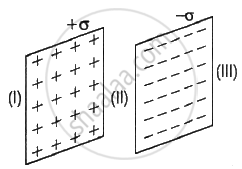Advertisements
Advertisements
Question
Answer the following question.
What is a uniform electric field?
Solution
A uniform electric field is a field whose magnitude and direction are the same at all points.
For example, the field between two parallel plates is shown in the diagram.

Uniform electric field
APPEARS IN
RELATED QUESTIONS
Choose the correct option.
Which of the following produces uniform electric field?
A charge +q exerts a force of magnitude -0.2 N on another change -2q. If they are separated by 25.0 cm, determine the value of q.
Solve numerical example.
Four charges of + 6×10-8 C each are placed at the corners of a square whose sides are 3 cm each. Calculate the resultant force on each charge and show in the direction and a diagram drawn to scale.
Solve numerical example.
A potential difference of 5000 volts is applied between two parallel plates 5cm apart a small oil drop having a charge of 9.6 ×10-19 C falls between the plates. Find
- electric field intensity between the plates and
- the force on the oil drop.
A conducting sphere of radius R = 20 cm is given a charge Q = 16 µC. What is `vecE` at centre?
The number of electrons to be put on a spherical conductor of radius 0.1 m to produce an electric field of 0.036 N/C just above its surface is ____________.
An electron is moving towards X-axis. An electric field is along Y-direction then path of electron is ____________.
An electron experiences a force equal to its weight, when placed in an electric field. The intensity of the field will be ______.
Radius of a metal sphere is 4 cm. It is given a charge of 8 µC. The force acting on unit area of its surface is ____________.
Deuteron and `alpha` - particle are put 1 Å apart in air. Magnitude of intensity of electric field due to deuteron at `alpha` - particle is ____________.
Two parallel plates separated by 'd' mm are kept at potential difference of 'V' volt. A particle of mass 'm' and charge 'q' enters in it with some velocity. The acceleration of the particle will be ______.
A particle of mass m and charge q is placed at rest in a uniform electric field E and then released, the kinetic energy attained by the particle after moving a distance y will be ______.
Electric field at the centroid of a triangle carrying q charge at each comer as
Electric field and potential inside hollow charged conducting sphere are respectively:-
A charged particle (mass m and charge q) moves along X axis with velocity V0. When it passes through the origin it enters a region having uniform electric field `vec"E" = -"E"hat"j"` which extends upto x = d. Equation of path of electron in the region x > d is :

A positive charge particle of 100 µg is thrown in opposite direction to a uniform electric field of strength 1 × 105 NC-1. If the charge on the particle is 40 µC and the initial velocity is 200 ms-1, how much distance it will travel before coming to the rest momentarily:
An oil drop of radius 2 mm with a density 3 g cm-3 is held stationary under a constant electric field 3.55 × 105 V m-1 in the Millikan's oil drop experiment. What is the number of excess electrons that the oil drop will process?
Consider g = 9.81 m/s2
The magnitude of the average electric field normally present in the atmosphere just above the surface of the Earth is about 150 N/C, directed inward towards the center of the Earth. This gives the total net surface charge carried by the Earth to be:
[Given: ε0 = 8.85 × 10-12 C2/N-m2, RE = 6.37 × 106m]
An inclined plane makes an angle of 30° with the horizontal electric field E of 100 V/m. A particle of mass 1 kg and charge 0.01 C slides down from a height of 1 m. If the coefficient of friction is 0.2, the time taken for the particle to reach the bottom is ______ sec.

The electric field in a region of space is given by, `vec"E"= "E"_"o"hat"i" + 2"E"_"o"hat"j"` where Eo = 100 N/C. The flux of the field through a circular surface of radius 0.02 m parallel to the Y-Z plane is nearly ______.
The expression for electric field intensity at a point outside uniformly charged thin plane sheet is ______. (d is the distance of point from plane sheet)
Consider the following statement about the electric field the intensity and the electric potential.
- The electric field intensity due to a charged spherical shell is inversely proportional to the square of its radius.
- The electric potential due to a point charge is inversely proportional to the distance between the charge and the point.
If the potential in a region of the electric field is expressed as V(x, y, z) = 2xy + 3zx - yz, then the electric field at point (0, 1, 1) is ______.
Find the electric field in region II as in figure shown.

